#Importance of Surveys on Substack
Explore tagged Tumblr posts
Text
Section 17: Adding Surveys to Substack
Summary of my Udemy Course “From Zero to Substack Hero.” Image source from the video location Purpose of this Series for New Readers If you are following this series, you can skip this intro and start from the next section. I have to introduce it to new readers as otherwise it will not make sense to them. This is a new series upon request from my readers. I recently developed a course titled…
#Adding Surveys to Substack#Do You Want to Go from ZERO to a Substack HERO in 2025?#From zero to Substack Hero on Udemy#grow your audience with surveys on Substack#Importance of Surveys on Substack#Join From Zero to Substack Hero on YouTube for free#Value of surveys for Substack newsletters
0 notes
Text
In a series of three studies, psychologists Lukas Wolf & Paul Hanel surveyed over 2,000 American Republicans & Democrats about their ‘fundamental values,’ and concluded that adherents to each party actually have a lot more in common with one another than they do sources of disagreement.
This lack of a meaningful difference between the two parties is, somehow, taken by the authors to be a positive and “hopeful” finding. Bizarrely, within a political paradigm in which over five million immigrants have been deported in the past four years, trans healthcare and abortion access are increasingly restricted, and $17.9 billion has been dispatched to Israel in the past year to support bombings in Gaza, Lebanon, and Iran, what many liberal political analysts consider to be most important is that members of the two parties don’t disagree with one another too much.
It seems to completely elude the authors’ grasp that it’s not necessarily a positive sign for a nation’s only major parties to be in lock step with one another on virtually all substantive issues. To really determine whether “polarization” is a threat to progress or a sign of necessary rebellion, you must consider what that polarized disagreement is even about.
This is a fact that liberal commentators always ignore when they fret about the distance between conservative and liberal voters, which has supposedly been widening for the last several decades. They presume that when two groups stake out strongly opposing positions, it must inherently be a negative thing. Disagreement, after all, leads to conflict, and conflict slows down production, and so it must be bad. But if one of the leading political factions in a country is arguing for the complete eradication of transgender people from public life, for example, it is a good thing for there to be intense polarization against it.
I wrote about bad social psychology research and why "political polarization" is not the problem that liberals make it out to be in my latest newsletter! It's free to read or have narrated to you by the Substack app at this link.
249 notes
·
View notes
Text
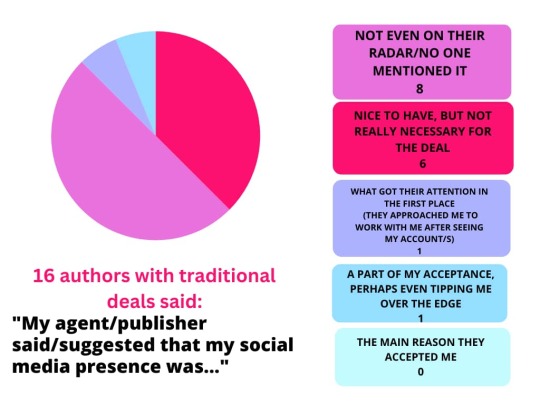

Do nonfiction authors really need social media to get a book deal?
I asked successful agents and trad signed authors how important social media is to getting book contracts. Here are some data and quotes about how they responded on my Authors of Nonfiction Books in Progress Substack! Read if you want more details and caveats to the data, as well as my story and why I like social media anyway.
TLDR: Social media is NOT necessary!
Here's an editorial explaining why. But for nonfiction non-memoir, you have to do something to prove that you know what you’re talking about, as you'll see repeated over and over in my Substack article. That proof could be social media.
Trad publishing is very hard and competitive, and sometimes even unfair. But the people who say "you can't get a deal unless you know someone or are TikTok famous" are flat-out wrong. (Also, you can become a person who knows someone by joining communities, attending conferences...hell, you can DM me if you have writing experience and I might hook you up with my agent. There, now you know someone and have no excuse. I've successfully hooked up 4 people I knew from communities I'm in, or something like that, not because they're my family members. I have said "come back when your query and/or experience are better" to 3 people, and 2 people didn't get the deal despite having good pitches and my recommendation, it just wasn't a match.)
Unfortunately, I think some aspiring authors are looking for an excuse, as many of these people don't often tend their writing craft. That is a much bigger indicator as to whether you'll get a deal, even if the trad world still isn't a perfect meritocracy.
Remember, I LOVE social media and have over 300,000 followers across platforms. I mostly do recommend that writers and journalists should use it! I find it sad, even, that there are so many writers with no audiences, when there are huge social audiences who would love to hear what these writers have to say! (But there are downsides too, so it's not ideal for all. Check out the pros and cons for science journalists being on TikTok.)
If you’d like to share your experience with trad publishing and social media (or lack of social media!), I still look at the survey results, so feel free to fill it out here and I may share the results in the future. Some questions are optional and of course I redact the (optional, anyway) emails:
132 notes
·
View notes
Text

Outer Rim Marches, #0.1
In January, I started a westmarches campaign for Mothership RPG. This is the first post in a series of play reports and mini-reviews I intend to share of the campaign-in-progress.
Let's call this post "Zero Session #1," in a series of Zero Session posts, where I'll get into the how/why of organizing and running this campaign.
Why? Well, I own a ton of Mothership modules. I've been playing and writing for Mothership RPG for over two years, yet most of my sessions became playtests and that "work-only" connection to the game was burning me out.
So, I decided to build a sandbox campaign around the physical MoSh games I have in hand, and to find folk to play at an open table.
For now, ok, sure, it's more of an open table sandbox for interconnected one-shots than a "true" westmarches game, especially since the game has only one GM (me, but I'm hoping to open that up soon). But Outer Rim Marches sounds cool, eh?
Initial Forward Operating Base (F.O.B.)

The PCs arrived at Sater's Redemption. They work for The Company, who hired them to represent their new presence amid a mess of other factions, and leases a ship, The Orpheus, to the Crew.
(We decided the official corporation name of The Company that owns their ship will be revealed in play. That hasn't happened yet, eight sessions later. I love hanging this important piece of worldbuilding in the balance for when it can have a bigger narrative impact. Not knowing wtf is going to happen is one of my favorite parts of running ttrpgs.)
The Crew's job: explore the Outer Rim to establish footholds in new trading hubs (F.O.B.s), discover novel exploitable resources (artifacts), capture profitable exobiological lifeforms, and spread the influence of The Company.
The above graphic might be familiar to folk who follow my substack, the 5 Million Worlds Rokaner Report. Each month, I release a free sci-fi adventure setting, and this station was the featured world in the April edition. A taste of things to come.
Game Organization
When I set out to recruit players, the first important bit was setting a firm, regular playtime. When people reached out, I sent them the Consent in Gaming fillable PDF to get an idea of collective Lines/Veils. Once I got that back, I sent a google survey to gauge interest in modules and game commitment to split folks into ping-able groups.
The playtime is working out well. We had one three week break, I was out sick one time, and only once did we have not have enough folk to play. Ten sessions out of a possible fifteen since January!
I kinda fucked up the module-interest part of the survey though. I listed module names, and without content tags this was pretty useless for the players (outside the BIG names, like Hull Breach). I intend to redo this survey soon, and I'll share a copy here when I do!
The player commitment bit was super helpful, at least. Since I run games on Discord, I split players into three groups: the Command crew who vote on which job to take, the mainline players are the Crew I ping each week to advertise the game (I make an "Event" in Discord), and and a final Cryo group to call on when games don't fill up right away.
This has worked super well for me, even when I drop the ball on giving the players the Event ping in advance.
The Sector Map

I built this hexmap using Sectors Without Number, which is a sector generator for Stars Without Number. I opted for this against the recommendations of Mothership's Warden's Operation Manual because in a westmarches campaign, from what I've understood, the world is meant to be established once the game begins. I think this is especially important should other GMs and player groups begin playing in this world.
To be blunt, I found using this is kind of annoying. There's a lot of irrelevant SWN info to delete, TONS of systems to hide individually, and it's pretty intensive to integrate module info into the systems.
In short, listen to Sean McCoy's advice in the Warden's Operation Manual if you're starting your own Mothership game and don't fucking do this, haha.
And to be honest, I'm not sold on this even being useful as a sandbox tool intended to be shared with other GMs, even. The verdict is still out. To be continued in another Zero Session post down the line.
ANYWAY! This map looks empty, but that's because it's the player-facing starcharts the Company gave them. PCs need to buy hyperspace route maps at various hubs to explore beyond these bounds. So the star and hyperlane layers hold loads of hidden info.
Feel free to poke around the current state of the sector.
And I do like the shift from a web to hexmap. Little swirls of points get me all crossed up. The Jump-drive distances in Mothership are amenable to using hexes, and tracking distance (i.e. time passed) is straightforward.
ORM Campaign Sneak Peek
Mothership space travel takes a long-ass time, in case you didn't know. To date, we've played nine adventures over ten sessions, and over two years have passed in the campaign world.
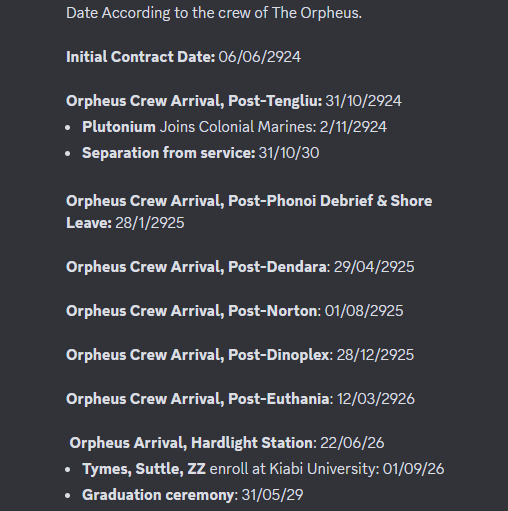
The players skipped over a lot of systems to go to Hardlight, which they've recently learned is on the edge of the Public Sector (from Hull Breach). Gonna be some interesting sessions coming up.
The next Outer Rim Marches post will be the official ORM#1, in which the players board the lauded Year of the Rat.
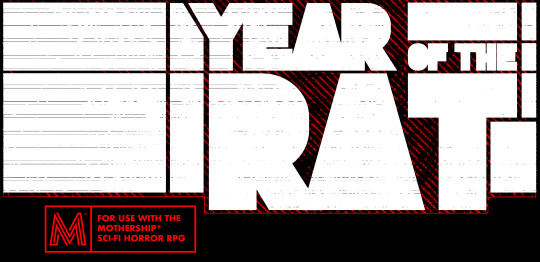
#indie ttrpg#ttrpg#rpg#horror#mothership#mothership rpg#role playing games#tabletop#osr#west marches#sci fi
30 notes
·
View notes
Text
By: Ryan Burge
Published: Apr 29, 2024
Sometimes I write a piece and a few weeks later I completely forget that I published it. I am not going to point out any specific examples on this Substack, but rest assured there are numerous occurrences where I've Googled an answer to a question and stumbled upon an article that I wrote at some point in my career, only to have forgotten about it entirely. As one of my homiletics professors said during my undergraduate studies, "not all sermons can be home runs." The same goes for public writing, I suppose.
But there are some little threads that I have exposed in earlier work that I just can’t shake. Sometimes, this is a result of giving a talk that goes really well and drives a lively Q&A, which then gets my mind spinning with possibilities. This was certainly the case when I was at Asbury University a few weeks ago, presenting some graphs from two posts that have run on Graphs about Religion.
They both circle around this idea that I have been exploring for a while—that religion doesn’t mean what most people think it means. Increasingly, it’s not some kind of theological ascent where people come to a clear understanding of Jesus, Mohammad, nirvana, etc. I just don’t think that’s how religion works in 21st-century American life. Instead, I believe that religion has been reduced to little more than a tribal marker, much in the same way that people say they are a fan of the Yankees, or they are Irish, or graduated from Stanford. It’s a way to create an "us vs. them" dynamic.
But there’s more evidence for this theory, too. There’s an increasing number of people who say that they are evangelical, yet they go to church less than once a year. Or, there’s a growing phenomenon of non-Christian faith groups like Jews, Muslims, and Buddhists who will tell survey administrators that they too are evangelicals. As I have shown, it’s pretty easy to predict why this is happening—it’s much more prominent among Republican non-Christians than among Democrats. Religion is not about a sense of the Divine; it’s about what tribe you associate with and what kind of cable news you consume.
So, consider this another entry into that larger discourse. This time I wanted to zero in on a small subset of people that I just can’t stop thinking about. Here’s the setup:
There are a handful of religion questions on mainstream surveys. One is, “How important is religion in your life?” Responses range from "not at all important" to "very important." They are also asked, “aside from weddings and funerals, how often do you attend religious services?” with response options that go from "never" to "more than once a week." Let me just show you how the sample breaks down on these two metrics in a heatmap.
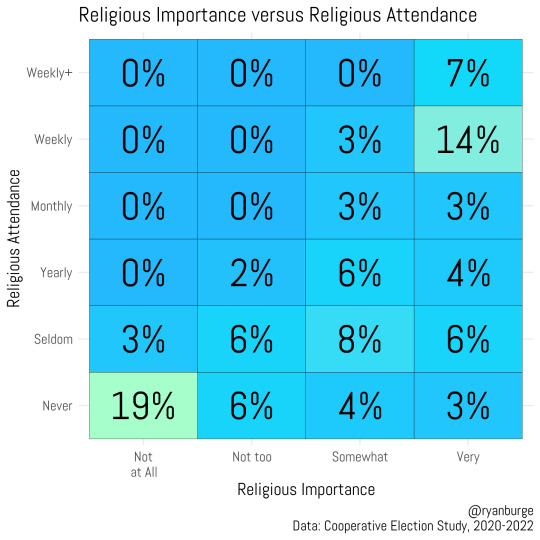
It should come as little surprise that the top left is sparse. Not a ton of people are high attenders but don’t think that religion is very important. That would be completely nonsensical. The most populated square is the bottom left—those who say that religion is not at all important and they never attend religious services—about one in five Americans fall into this box. In fact, the bottom left four boxes comprise about a third of the entire sample—that’s low attendance and low importance.
In contrast, about 7% of folks attend more than once a week and say that religion is very important. The top right four boxes equal about a quarter of the sample—those are the more religious folks.
But look at the bottom right, that’s where I wanted to focus my attention for this post. Specifically on people who meet two criteria:
They say that religion is very important.
They report their religious attendance as seldom or never.
In the sample from the last couple of years, that equals about 9% of folks. That’s not nothing. In fact, if you extrapolate that out to the adult population of the United States, that might mean 20-25 million people are high importance/low attendance.
Is there a growing trend, though? Are more and more people saying that they think religion is important, then just not showing up for a weekend service?
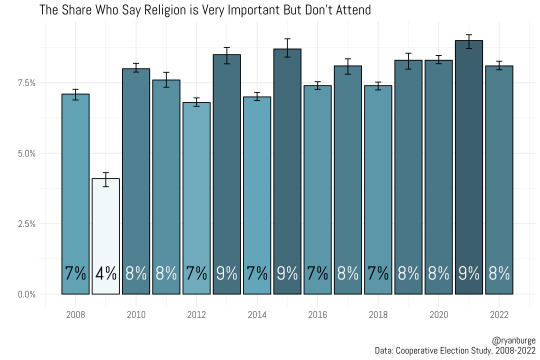
I’m not sure if that’s the case or not. There may be an increase in the trend line, but it’s not a huge one. Between 2008 and 2012 (let’s exclude 2009 as an outlier), I’m pretty confident in saying 7-8% met this criterion. But that figure has slowly crept up over time. Now, since 2019, the share who check both these boxes is likely in the 8-9% range. So, I think it’s fair to say that it’s a growing phenomenon, but not a rapidly growing one.
But I had to look under the hood of this one just a bit. Are there certain factors that seem to be driving this phenomenon of cultural religious people? Obviously, politics was the first thing that came to mind. So, here’s the trend line for Democrats, Independents, and Republicans between 2008 and 2022.
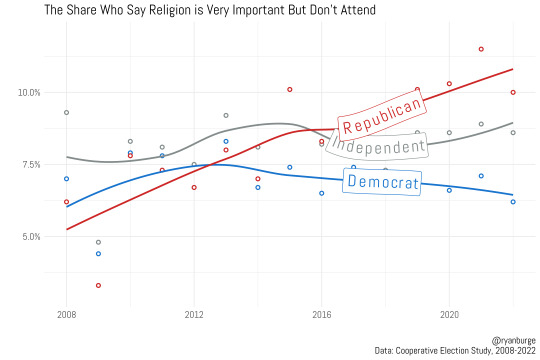
Okay, now I think we can see a clear shift. Among Democrats, the share who say that religion is very important but don’t go to church is stable over time. It was about 6% of them in 2008, and it’s essentially the same share today. For Independents, it’s probably a modest increase. It hovered around 7.5% for a while during Obama’s first term, then began to slowly creep up. Now, it’s probably the case that 8.5-9% fall into this camp.
But among Republicans, there’s no mistaking what is happening here. The share who are culturally religious has risen quickly. It was about 5% of all Republicans in 2008 who said that religion was very important but they attended services less than once a year. The trend line in 2022 was just about 11%. So, today, a Republican is twice as likely to be culturally religious compared to a Democrat.
I had to take a look at age, but I really had to think about how to visualize this in a way that is not deceiving. Because there’s a big problem when you combine two metrics like this: a lot more older people say that religion is very important compared to young adults. In fact, it’s 50% of those in their seventies, versus just about a quarter of college-aged young people. So, of course, more older people are going to be culturally religious, just based on that criterion.
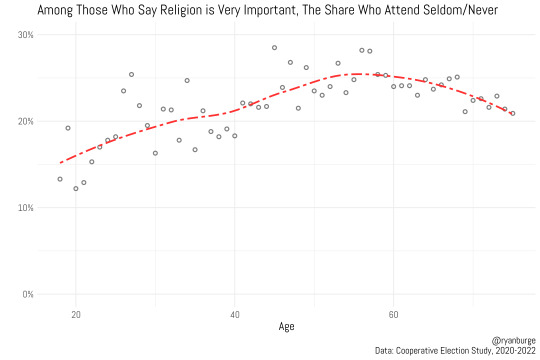
So, I had to switch it up a little. I restricted the sample to just people who said that religion was very important, and then I calculated the share who described their religious attendance as seldom or never. This gets us closer to the actual reality.
About 15% of younger folks place a high value on religion but just don’t go to religious services, but the share begins to climb from that low point. Among 40-year-olds, it’s just slightly more than 20% who are in the seldom/never category of attendance. It really peaks among people in their fifties. Among 55-year-olds who say that religion is very important, a quarter go to church less than once a year. It does decline a bit beyond that point, but it’s still north of 20% even among folks in their seventies.
I wanted to put a little bow on this post by putting all this to a more rigorous test—a regression analysis. The dependent variable is identifying as culturally religious (religion is very important + I attend less than once a year). I threw all the basic suspects into the model—age, income, gender, race, education, and political conservatism. This model is awesome because everything is predictive in one way or another. That’s not usually the case.
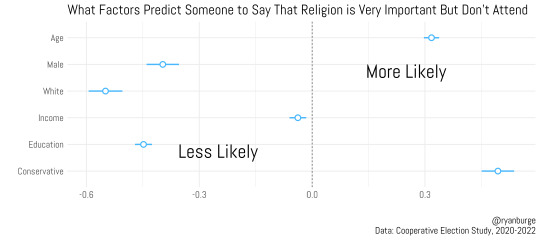
There are four factors that predict a lower likelihood of being culturally religious: income, education, being white, and being male. The one with the largest coefficient is race. A white respondent is significantly less likely to be culturally religious compared to people of color. This is followed by gender and education. The least predictive is income, but it’s still statistically significant. All drive a lower likelihood of cultural Christianity.
There were two factors that make someone more likely to say that religion is very important but they don’t go to church: age and political conservatism. All things being held equal, older people are more likely to be culturally religious. The same is true for being a conservative.
I don’t why but I can’t stop conjuring an image in my mind when I was thinking through this data - this is Andy Griffith Show fans. It ran for eight seasons in the 1960s. In many ways it’s the most wholesome show you can get. No sex, no drugs, no swearing. Just good morals. Ted Koppel went to a small town in North Carolina that was Griffith’s birthplace. It’s revitalized it’s economy by becoming a haven for tourists to revisit a bygone era.
They like the clean, wholesome nature of Mayberry. They watched the show as kids. They want to go back to that earlier time. But they just can’t manage to make it to church. They want to recreate the era of Andy Griffith, but not expend the actual effort of sitting in a pew on a Sunday morning. It’s just another example of people who like the idea of religion, but not the actual religious part.
#Ryan Burge#culturally religious#cultural christianity#empty the pews#decline of religion#religion#christianity#religion is a mental illness
5 notes
·
View notes
Text
We launched the After Babel Substack eleven months ago, on Feb 1, 2023. We’ll have a post next February reflecting on our first year and looking ahead to our second. In this post, we highlight a few of our 31 posts that readers seemed to enjoy most, and that we believe are the most essential readings for those following this Substack.
The central question animating the After Babel Substack is this: Why does it feel like everything has been going haywire since the early 2010s, and what role does digital technology play in causing this social and epistemic chaos? We explore the chaos in two primary domains: adolescent mental health (which has been our focus this year, as we worked on The Anxious Generation), and liberal democracy (which will become increasingly important in late 2024, as we begin to work on the second part of the Babel project, a book tentatively titled Life After Babel: Adapting to a world we can no longer share).
The main line of our work so far can be summarized like this: We have shown that there is an adolescent mental health crisis and it was caused primarily by the rapid rewiring of childhood in the early 2010s, from play-based to phone-based. It hit many countries at the same time and it is hitting boys as well as girls, although with substantial gender differences.
Here is that main line in five posts, with a figure from each post:
Social Media is a Major Cause of the Mental Illness Epidemic. Here’s the Evidence. By Jon Haidt
This post frames the research debate and then summarizes the empirical evidence showing that heavy social media usage is a major cause, not just a correlate, of adolescent mental illness and suffering. (I also wrote a response to skeptics who critiqued this post.)
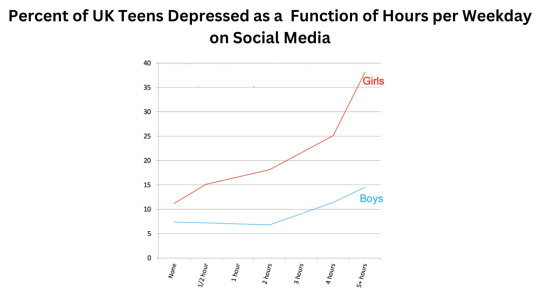
Figure 1. Percent of UK adolescents with “clinically relevant depressive symptoms” by hours per weekday of social media use. Haidt and Twenge created this graph from the data given in Table 2 of Kelly, Zilanawala, Booker, & Sacker (2019).
Here are 13 Other Explanations for the Adolescent Mental Health Crisis. None of them Work. By Jean Twenge
Jean Twenge, who was among the first to diagnose the problem in 2017, raises 13 alternative theories that we often hear and shows why they don’t fit the facts. They certainly can’t explain why the crisis hit so many countries in the years around 2013. Figure 2 shows Twenge’s response to alternative #4, that it was caused by the 2008 Global Financial Crisis. It wasn’t:
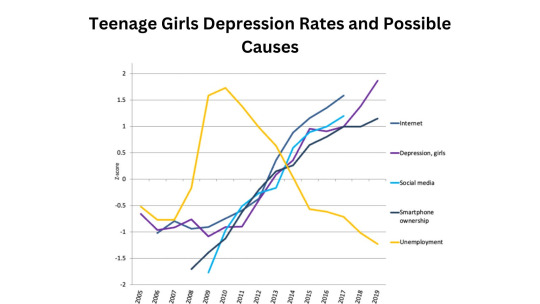
Figure 2. Technology adoption, teen depression, and national unemployment, 2006-2019. Sources: National Survey of Drug Use and Health, Monitoring the Future, Pew Research Center, Bureau of Labor Statistics. See also Figure 6.39 in Generations.
The Teen Mental Illness Epidemic is International, Part 1: The Anglosphere. By Zach Rausch and Jon Haidt
This is Zach’s first post in a series exploring the crucial question: Did the adolescent mental health crisis just arise in the U.S., which would guide us to investigate causes within American society? Or did it happen in many other countries at the same time, which would point us to causes with transnational reach, such as digital technology? The answer so far: It hit big in countries that are wealthy and individualistic, such as all five Anglosphere nations. Part 2 shows the same trends in the five Nordic nations. A subsequent post shows that the international problems go beyond depression and anxiety—Gen Z girls’ suicide rates are up across the Anglosphere. (Zach is currently working on a post showing that the worsening trends are widespread across Western Europe).
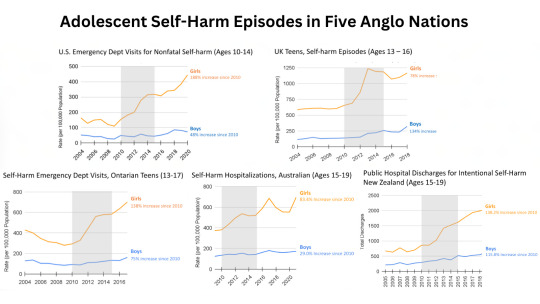
Figure 3. Since 2010, rates of self-harm episodes have increased for adolescents in all five Anglosphere countries, especially for girls. For data on all sources, and larger versions of the graphs, see Rausch and Haidt (2023).
Why the Mental Health of Liberal Girls Sank First and Fastest. By Jon Haidt
This post picks up the analysis offered in The Coddling of the American Mind, whose subtitle is “How good intentions and bad ideas are setting up a generation for failure.” The post shows how three very bad ideas were nurtured on Tumblr, around 2013, and then escaped into progressive online communities (and ultimately into progressive real-world communities such as university campuses), leading to a sharp rise in signs of depression, anxiety, and hopelessness that was most pronounced in young women on the left. Just as Greg Lukianoff had predicted, these ideas amounted to performing “reverse CBT” on those who embraced them.
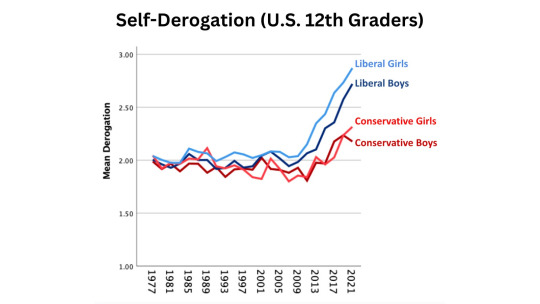
Figure 4. Self-derogation scale, averaging four items from the Monitoring the Future study, e.g., “Sometimes I think I am no good at all,” and “I feel that my life is not very useful.” The scale runs from 1 (strongly disagree with each statement) to 5 (strongly agree).
Why I am Increasingly Worried About Boys, Too. By Jon Haidt
If you only look at published studies on social media and mental health, you’ll conclude that this is mostly a girl problem. Girls use social media more than boys and are more affected by it. But as Zach assembled all the research we could find about boys’ mental health, we found that boys are suffering just as much as girls, though in different ways. Boys’ sense of meaning and purpose collapsed as they retreated from the ever less appealing real world into an ever more immersive and addictive virtual world of video games, porn, social media, and online forums.

Figure 5. Percent of U.S. 12th graders who agreed with the statement: “People like me don’t have much of a chance at a successful life.” Source: Monitoring the Future 1977-2021, 2-Year Buckets, Weighted).
5 notes
·
View notes
Text
Fascinating Fascia: Kate Oland Galligan Unravels the Ties That Bind | TAPP 152
Episode 152 centers on a lively conversation between Kevin and Dr. Kate Oland Galligan as they trace her path from a curious undergrad to a passionate fascia educator and clinician. The duo challenges old perceptions of fascia, recounting stories from early lab experiences where fascia was simply “ripped out,” and contrasting them with new insights on its dynamic, interconnected nature. They reveal how subtle fascial restrictions can cause significant clinical symptoms—linking pelvic imbalances to jaw pain—and explore the emerging field of mind-body connections in fascial therapy.
0:00:00 | Introduction
0:00:55 | Introducing Kate Introducing Fascia
0:17:06 | Fascia Mini Lesson *
0:20:00 | Rip That Fascia Out!
0:37:14 | Get Ready for Annual Debriefing
0:39:00 | The Hip Bone is Connected to the Jaw Bone
1:03:08 | We’re on Substack! *
1:06:13 | Mind-Body Connections
1:21:45 | Staying Connected
* Breaks
★ If you cannot see or activate the audio player, go to: theAPprofessor.org/podcast-episode-152.html
🏅 Apply for your credential (badge/certificate) for listening to this episode: theAPprofessor.org/podcast-episode-152.html/#badge
⭐⭐⭐⭐ Please rate & review this podcast so that others can decide whether to give it a try: RateThisPodcast.com/theAPprofessor
❓ Please take the anonymous survey: theAPprofessor.org/survey
☝️ Questions & Feedback: 1-833-LION-DEN (1-833-546-6336)
✔️ Follow The A&P Professor on Twitter, Facebook, Blogger, Substack, Tumblr, or Instagram! @theAPprofessor
📰 Get the once-or-twice-weekly TAPP Science & Education Updates theAPprofessor.org/updates
Understanding fascia requires abandoning the traditional anatomical view of separate structures and embracing a model of interconnected, living tissues. (Jean-Claude Guimberteau)
Introducing Kate Introducing Fascia
16 minutes
In this segment, Kevin reconnects with Dr. Kate Oland Galligan, a former student who has since become a passionate fascia educator and clinician. They reminisce about their time studying physiology together, sharing a nostalgic moment about the infamous Krebs cycle. Kate shares her professional journey from graduate school to clinical practice, detailing how she discovered her deep interest in fascia. As she explains, her dual role as both an instructor and practitioner has given her unique insights into why fascia deserves more attention in undergraduate education. Their conversation sets the foundation for an in-depth exploration of fascia’s overlooked importance in both teaching and clinical applications.
Fascia Mini Lesson
3 minutes
In this short break, Kevin introduces lionden.com, a website he created to offer students supplemental resources for learning A&P. He highlights the value of his “mini lessons,” which provide quick, digestible overviews of complex topics like fascia. These digital outlines help students reinforce their understanding beyond textbooks, offering interactive elements and structured learning aids. He encourages listeners to explore the site for additional learning tools, emphasizing the importance of creative, digital-friendly resources in modern anatomy and physiology education.
Rip That Fascia Out!
17 minutes
This segment takes a deep dive into how fascia has traditionally been misunderstood, especially in dissection labs where it was often “ripped out” to expose muscles, minimizing its true significance. Kate recalls her early anatomy lab experiences and how her perspective on fascia evolved once she began working in clinical practice. They discuss groundbreaking research showing how living fascia is dynamic and responsive, unlike the dehydrated tissue seen in cadavers. The conversation delves into the clinical impact of fascial restrictions, revealing how small, seemingly minor adhesions can generate significant pressure and pain throughout the body. These insights challenge the old paradigm that fascia is merely a passive, structural tissue.
Get Ready for Annual Debriefing
3.5 minutes
In this "brain break," Kevin teases the upcoming annual debriefing episode, a tradition where he reflects on past predictions about A&P teaching and makes new ones for the coming year. He invites listeners to contribute their own thoughts, concerns, and expectations for the future of anatomy and physiology education. This segment reinforces the podcast’s interactive and community-driven nature, encouraging engagement and discussion among educators.
The Hip Bone is Connected to the Jaw Bone
12 minutes
During this segment, Kevin and Kate explore the surprising connections within the fascial system, such as how pelvic imbalances can influence jaw function and why scar tissue in one area can affect movement and pain in another. Kate explains her approach to treating fascial restrictions, emphasizing the importance of sustained holds, sometimes lasting several minutes, to allow the tissue to release and rehydrate. Their discussion highlights how posture, embryological development, and past injuries all interact through fascia, reinforcing the idea that the body is not a collection of separate parts but rather an interconnected whole.
We're on Substack!
3 minutes
During this break, Kevin shares exciting news about his weekly science and teaching updates now being available on Substack. He explains how this platform blends newsletters with social media-style engagement, allowing educators to stay informed about the latest A&P breakthroughs and pedagogical trends. He encourages listeners to explore Substack as a way to connect with a broader community of professionals who are passionate about anatomy and physiology education.
Mind-Body Connections
15.5 minutes
This segment shifts the discussion toward the emotional aspects of fascial therapy. Kate delves into the idea that past trauma—both physical and emotional—can become “stored” in the fascia, sometimes manifesting as pain or tension. She shares experiences from her clinical practice where patients have had unexpected emotional responses during treatment, suggesting a deeper link between fascia and the nervous system. Kevin and Kate discuss ongoing research into tissue memory, acknowledging that while much remains to be studied, the connections between fascia, emotional well-being, and physiological function are becoming increasingly evident. This conversation bridges science and clinical practice, opening the door for more integrative approaches to healing.
Note: Kate's new search engine to find healing where you are right now—Thrive Anywhere—will be available in June 2025. Stay tuned to The A&P Professor for more news on this.
Links
★ Books:
The Body Keeps the Score: Brain, Mind, and Body in the Healing of Trauma (Bessel van der Kolk) geni.us/FvQBXS
🏅 Claim your credential for reading this book. AandP.info/zoh
Architecture of Human Living Fascia: The Extracellular Matrix and Cells Revealed Through Endoscopy (Jean-Claude Guimberteau, Colin Armstrong) geni.us/oj0v2
Functional Atlas of the Human Fascial System (Carla Stecco) geni.us/iPkbA
Anatomy Trains: Myofascial Meridians for Manual Therapists and Movement Professionals (Thomas Myers) geni.us/42JLTw
Anatomy & Physiology (textbook by Kevin Patton, Frank Bell, Terry Thompson, Peggie Williamson; includes online article Whole Body Muscle Mechanics that relates to the fascial system) geni.us/hcRF
★ Myofascial Release (John Barnes website) myofascialrelease.com
★ Strolling Under the Skin (YouTube video) youtu.be/eW0lvOVKDxE?si=7_GYm5TG-sonoujz
★ The Strength for Tension and Bursting of Human Fasciae (scientific summary of tension in fascia) AandP.info/t1g
★ Fascia Documentary: The network of the body without beginning or end (YouTube video) youtu.be/3uK92zS8qq8?si=5B3V21KWXHfrMHxp
★ Bone Tissue is an Integral Part of the Fascial System (journal article about whether organs can be part of the fascial system) AandP.info/55098e
★ Clinical Anatomy: Volume 32, Issue 7. Special Issue on Fascia. AandP.info/1t7
★ The body electric: soft tissue makes electricity under stress (article in Nature) AandP.info/c0416a
★ Response to Mechanical Properties and Physiological Challenges of Fascia: Diagnosis and Rehabilitative Therapeutic Intervention for Myofascial System Disorders (article in Bioengineering) AandP.info/e0f65e
★ Brain Breaks are Essential for Learning AandP.info/ksx
★ Related episodes & resources
Fascial System Mini Lesson (Kevin's sketchy overview outline for students) lionden.com/fascial-system.htm
Chaos Mini Lesson (explains how concepts of chaos, including fractal geometry, applies to the human body) lionden.com/chaos.htm
The Fractal Body Mini Lesson (introduces the concept of fractal-like anatomy in the body) lionden.com/fractal_body.htm
Pulse of Progress: Looking Back, Moving Forward | TAPP 147
Is Anatomy Finished? | A Review of New Discoveries | TAPP 105
Ten Things We Forget to Tell Students About Cells | A Forest in My Office | TAPP 126
Test Debriefing Boosts Student Learning | Episode 11
People
Production: Aileen Park (announcer), Andrés Rodriguez (theme composer, recording artist), Karen Turner (Executive Editor), Kevin Patton (writer, editor, producer, host).
Not People
Robotic (AI) audio leveling/processing by Auphonic.com, initial draft transcript by Rev.com, and the content, spelling, grammar, style, etc., of these episode notes are assisted by various bots, such as ChatGPT, Grammarly, and QuillBot.
If the hyperlinks here are not active, go to TAPPradio.org to find the episode page.
★ More details at the episode page: theAPprofessor.org/podcast-episode-152.html
★ Transcript available in the transcript box: theAPprofessor.org/podcast-episode-152.html
★ Need help accessing resources locked behind a paywall? Check out this advice from Episode 32 to get what you need! my-ap.us/paywall
Take The A&P Professor experience to the next level!
★ theAPprofessor.org/community
Earn cash by referring other A&P faculty to this podcast:
★ theAPprofessor.org/refer
Tools & Resources
★ TAPP Science & Education Updates: theAPprofessor.org/updates
Follow The A&P Professor on Twitter, Facebook, Mastodon, Reddit, TikTok,LinkedIn, Blogger, Substack, Tumblr, or Instagram @theAPprofessor
The A&P Professor® and Lion Den® are registered trademarks of Lion Den Inc. (Kevin Patton)
Check out notes and transcript for this episode!
0 notes
Text
To Keep A Highly-Engaged Audience on Substack Do This

According to Substack, “Substack open rates vary widely depending on the niche, audience, and content of the newsletter. According to a recent survey, the average open rate for Substack newsletters is around 50%. However, some newsletters can achieve an open rate of 70% or higher, while others struggle to reach 20%.”
As a newsletter publisher on Substack, it’s important to retain a highly-engaged audience…and trim the fat on a regular basis. If you don’t know already, it’s vital that you keep a clean list at all times. Here’s how to do it on Substack:
👉Go to your subscribers tab on Substack
👉Count the first 30 subscribers on the list
👉You will see some stars next to their name. Scroll over to the far right of their name. There will be 3 little dots. The options will be “send message,” “edit subscription,” and “remove from list.”
👉Remove from the list all of the subs that after that list of 30 subs do not have any stars by their name. The first 30 names you can keep.
👉After you’ve done that, go back and “remove from list” every person that doesn’t have at least 2 stars, meaning they opened the initial email (which gives one star) but they never came back to read more, which means they’re NOT ENGAGED. And you don’t want that. Remember, we are trying to build an ENGAGED audience.
To keep your list clean, engaged, and with a high open rate, do this on a DAILY basis.
Remember, if you run a paid newsletter on Substack, offer 10 lifetime paid comps to your most loyal readers as a reward. Do this every 3 months, as a way of saying “Thank you!”
What is your open rate on Substack? Let me know in the comments section if you’d like to disclose and drop a link to your Substack newsletter.
Continue reading on Substack
0 notes
Text
the internet diverges again
(if you're a regular Garbage Day reader, a lot of this may sound very familiar to you, as i'm borrowing heavily from conclusions Ryan keeps drawing as well. my thoughts below are my own, and kinda rambling because i don't really have any strong conclusions yet, just speculation that keeps me up at night.)
feels to me like the internet is diverging yet again, into two primary modes of user experience:
the new FM radio. this is what TikTok is, and YouTube has been for a long time. it's massive, it's impossible to ingest all of it or even a fraction of it, and it moves so fast that the vast majority of people can be nothing but passive consumers. it's a lean-back, wayyy back, experience on these platforms. the key difference today, from actual FM radio, is how much the experience is personalized and molds itself in real time to you as the consumer. more and more people want to tune out of the active social media model and into the hyper-passive radio model. you don't have to even follow anybody, the content comes to you, just like the radio. sit back, relax, swipe up, watch, keep swiping, the next piece of content will be more suited to you than the last, head empty no thoughts.
the archipelago. this is what Discord is, and what Reddit subreddits are, and what Substack newsletters are, and Minecraft servers, and why people gravitate towards them. people do still want a sense of belonging, and we've all agreed lately that such a thing is way too much work on the slightly-customizable-algo-feeds of Twitter or Facebook. this is a polar opposite of the new FM radio model above, because this archipelago requires deep commitment, buy-in, and time investment. and the islands are inherently getting smaller and smaller and smaller and more nostalgic and like the message boards of the 00s. the key point being that they're independent, separate, and feel owned and controlled by their inhabitants. there can't/won't be an index of them.
i think these two paths are in stark contrast with what the predominant UX model has been over the last 15 years, which is that slightly-customizable centralized walled garden algorithmic feed that is what Twitter, Facebook, and Instagram have been perfecting, and is now wholly inadequate. and those platforms keep trying to compete with TikTok, but in the wrong way. it's not about video, nor even the infinite feed, it's about the extremes of ownership and depth of involvement.
in this new context, the traditional walled garden feeds now feel like work with little reward, and TikTok doesn't feel like work at all, with lots of reward. Discord feels like deliberate work with reward. it's those different patterns of passive and active reward that feel so disrupted by TikTok, which is not a UI feature, it's the whole thing. you can't just slap a feed of recommended videos into Instagram and get the same result, now that we consumers are all more wise to it.
i'm somewhat excited about this shift because underneath these new-but-old paradigms are important shifts in our relationship to the products and our actual ownership of them. Discord relies on subscription money, not ads; they survey paying users to figure out what to build next, and it seems to work at scale and make people feel like they really own their servers. TikTok runs ads the way radio runs ads, except far more deeply personalized, because they have the mount everest of attention data (which is not the same as Facebook's relational targeting data). it's very clear that you own nothing on TikTok or YouTube, you're just a passively floating leaf in an ocean of content.
i'm also excited about this shift because it means we're in fertile territory for products, both new and existing, to figure out where they belong and if they can adapt. TikTok and Discord feel like the two opposite axis points to me, in terms of product ownership, anonymity, tracking behavior, attention economy, etc. if both worlds are feasibly sustainable, then that's great news for those of us who want to cultivate safer, smaller places to coexist on the internet. there is a whole spectrum of possibility to explore here and lean into. it comes with a myriad of new problems, but arguably, we never figured out a lot of the core problems with the old model anyway, so what's it worth?
no conclusions here, just a lot of thoughts.
245 notes
·
View notes
Photo

An amusing flourish in the picture caption to Justin Murphy’s newsletter on Flannery O’Connor: “When was the last time you heard about Elizabeth Hardwick?” The cognoscenti have been hyping a Hardwick revival for half a decade now, to semi-avail. I got in on the game in 2017 by reading her little Herman Melville bio; I wrote about it here. For what it’s worth, I think that’s one of the funnier essays I’ve ever written:
All of the above to say that I approach Hardwick, at this stage of my reading life, with a bit, just a hint really, the proverbial soupçon, whatever that means, of suspicion—with apprehensions of fatigue. These days, for me, somehow, the New York Intellectuals, The New York Review of Each Other’s Books, have lost their luster. If I don’t care about Bloomsbury, why should I care about this even less generally relevant coterie? Their organs have been disintermediated, their politics obsolesced, in the thresher of the 21st century. The problem with ressentiment and separatism, though, is that you miss too much of relevance to yourself, because you have artificially constricted your own soul too far in advance of experience. Lady Ottoline Morrell, Barbara Epstein—sure, if you’re not in the club, who cares? But you would not want to miss a Virginia Woolf, not even in the 21st century: so to Hardwick’s Melville I go.
I suspect Murphy may have had in mind that recent survey that showed the average reader of the New York Review of Books to be, in age terms, pretty much deceased.
I never did read Hardwick’s most celebrated novel Sleepless Nights, with all those blurbs from Sontag, Roth, Didion. I started it right after I read Adler’s Speedboat and it was too similar so I put it down. These aren’t universal writers, Adler and Hardwick, in the way that O’Connor is a universal writer. It’s a different order of being. I may have heard about Hardwick lately—and she’s okay, very intelligent, very civilized; I do think her metropolitan milieu partially liked her so much because she escaped from Hicksville, and I increasingly detest that kind of thing—but nobody would say about her what (if I recall) Robert Fitzgerald said about O’Connor: that she should be mentioned in the company not of Hemingway but of Sophocles. Which might go too far, but is in the ballpark.
youtube
Speaking of mid-to-late-20th-century American letters: over in Tablet, at whose Substack annex I myself sometimes appear, David Mikics nominates Ralph Ellison, Joan Didion, Thomas Pynchon, Flannery O’Connor, and Elizabeth Bishop as the most important postwar American writers and the antidotes to today’s over-politicized rage. No quarreling with the list—I appreciate that he said Bishop where one is probably supposed to say Ashbery—though a little Saul Bellow and a little Don DeLillo wouldn’t be amiss.
If literature can teach anything, it is patience and conviction. We mostly have neither. We lash out violently, apocalyptic and urgent, with our enemies’ lists in hand. The days of rage have returned, both on the right and the left. To weather these tantrums, we should turn back to the writers who oppose the infantile fervor of groupthink—who acknowledge the lostness of the self in the world, the first step to declaring independence.
And speaking of Don DeLillo, I spent the last week and half gratuitously and luxuriously rereading the massive Underworld—truly one of the best books there is—and I wrote about it at length here. Of DeLillo’s oeuvre, I still need to read End Zone and Ratner’s Star, both of which I’ve avoided on principles that have stood me in good stead since grade school: I don’t care about sports and I don’t care about math. And it’s been so long since I read The Names and Mao II that those readings probably don’t count. Underworld, though, is where it’s at, as I write:
For Underworld is, first of all, in the high tradition of the American novel, which, as umpteenth observers from Nathaniel Hawthorne forward have told us, has never been a novel at all, not a sober realist social survey, but a weird symbolic prose-poem, an inward voyage projected out onto the national landscape. Underworld places itself in this tradition with its first sentence: “He speaks in your voice, American, and there’s a shine in his eye that’s halfway hopeful.” The first thing to say about this sentence is that it pays tribute to two sentences from the Great American Novels of the early 1950s, the period when Underworld begins: the first sentence of Bellow’s Adventures of Augie March (“I am an American, Chicago born”) and the last sentence of Ellison’s Invisible Man (“Who knows but that, on the lower frequencies, I speak for you?”). The second thing to say is that, like a line of poetry, the sentence admits of two readings, with “American” as either a noun, which makes the sentence a direct address to the American reader, or an adjective modifying “voice,” declaring a national origin and destiny for the novel’s style. So this is an American romance, and you have to read it like a poem; and, as in Bellow’s and Ellison’s novels, or Faulkner’s and Melville’s before them, the sensibility and suffering that emerges is less the sojourning protagonists’ and more that of the organizing and presiding consciousness. As in a book of poems or in a long poem, it’s the poet you get to know best, and not for nothing does Underworld, in its final one-word sentence, echo no novel at all but the century’s most famous poem, The Waste Land. “Shantih shantih shantih,” Eliot chants in Sanskrit, which DeLillo puts into plain American: “Peace.”
#american literature#flannery o'connor#elizabeth hardwick#don delillo#justin murphy#david mikics#literary criticism
4 notes
·
View notes
Text
Substack Mastery Book: Chapter 17
How to Use Online Polls on Substack Effectively Non-members can read this important chapter for free here. I have been using surveys and polls for many years. Polls are quick and narrow in scope, while surveys are more detailed and aim to collect deeper insights. They have helped me gather information and validate my hypotheses during my postgraduate studies, enabling me to produce more…
#" "How blogs drive traffic to your Substack" "#Boost Engagement with Substack Polls#business#Freelance Writers Audience Insights#Freelance Writing Audience Feedback#Hypothesis development#Interactive Content for Newsletters#Knowledge Acquisition through Online Polls#Online Polls for Newsletters#Polls for Content Strategy#Polls for Freelance Writer Growth#Quality enhancement through online polls#Substack Mastery book by Dr Mehmet Yildiz#Substack Mastery Chapter 17#Substack Polling Best Practices#Surveys#technology#Using Polls in Substack#writers#writing#writingcommunity
0 notes
Text
Gesture emoji: contributing to the Unicode standard
In the conclusion of the paper that I wrote with Gretchen McCulloch on the way emoji function as digital gestures, we noted:
The paradigm of emoji as digital gesture has potentially important ramifications for the Unicode Consortium's emoji proposal and approval process. The Consortium has a dedicated Emoji Subcommittee,[5] which has been responsible for expanding the number of emoji in Unicode from the original set of 176 in 1999 to 2,784 in Unicode v. 11.0, and the demand for further emoji expansion shows no sign of slowing down.[...] The analysis of emoji as gesture can help inform future emoji encoding by incorporating evidence from names for emblem gestures and even typological surveys of common gestures across cultures.
Since we wrote that paper, I’ve been working with people at Unicode to bring some of the gesture literature to the emojification process. I’ve helped write two guideline documents as part of the updated process for proposing new emoji:
ESC Guidelines around Gestures and Emoji (L2/20-274)
Gesture Emoji for Consideration, Unicode 15.0 (L2/20-282)
It’s not always the case that when you make a suggestion at the end of an academic paper that you get the chance to so directly implement that suggestion!
If you’re thinking of submitting a gesture emoji I hope that these documents are useful. This process has also really stressed for me just how little we know about the diversity of emblem gestures across cultures and regions (another observation from the conclusion of that paper and something I hope to start working on).
Update from Unicode on emoji proposal submission:
When you last heard from the Unicode Emoji Subcommittee in April of 2020, the Unicode Consortium had just announced a 6-month delay to Unicode Version 14.0 due to COVID-19. Despite all of this :waves at the world: we’ve been busy. What’s new? Great question! During this pause in proposal submissions, the Unicode Emoji Subcommittee consulted with experts, developing a process that more completely reflects our criteria for inclusion in an effort to prioritize globally relevant emoji. We’ve looked for new ways to reconcile the rapid, transient nature of modern communication with the formal, methodical process required by a standards body like the Unicode Consortium. Moving forward, the proposal review season will be open each year from April 15-August 31. To submit a proposal, first read these Guidelines and fill out this form.
Additional links and info:
Emoji as Digital Gestures in Language@Internet
A summary of my paper with Gretchen McCulloch, which looked at the way emoji with text are similar to the way we use gesture with speech. Page also includes links to related content.
What Would Jennifer Do?
This is a substack newsletter from Jennifer Daniel, who has lots of interesting things to say about emoji, and just happens to also be the Emoji Subcommittee Chair. Her most recent post is about the re-opening of proposals.
Hello Old Friend 👋
“When there are as many foods as there are ingredients in the world, as many genders as there are people on the planet, and a variety of objects only limited by your imagination, every addition to the emoji palette is at risk of creating zones of exclusion without consciously trying”
Emoji Wrap episode 20
“🚀 Should there be a cyclone emoji for both the southern and northern hemisphere? Are pink ballet shoes problematic? How the future of the emoji keyboard is being shaped and the questions it raises. With special guest Jennifer Daniel, Chair of the Unicode Emoji Subcommittee.”
48 notes
·
View notes
Link
Imagine that the US was competing in a space race with some third world country, say Zambia, for whatever reason. Americans of course would have orders of magnitude more money to throw at the problem, and the most respected aerospace engineers in the world, with degrees from the best universities and publications in the top journals. Zambia would have none of this. What should our reaction be if, after a decade, Zambia had made more progress?
Obviously, it would call into question the entire field of aerospace engineering. What good were all those Google Scholar pages filled with thousands of citations, all the knowledge gained from our labs and universities, if Western science gets outcompeted by the third world?
For all that has been said about Afghanistan, no one has noticed that this is precisely what just happened to political science. The American-led coalition had countless experts with backgrounds pertaining to every part of the mission on their side: people who had done their dissertations on topics like state building, terrorism, military-civilian relations, and gender in the military. General David Petraeus, who helped sell Obama on the troop surge that made everything in Afghanistan worse, earned a PhD from Princeton and was supposedly an expert in “counterinsurgency theory.” Ashraf Ghani, the just deposed president of the country, has a PhD in anthropology from Columbia and is the co-author of a book literally called Fixing Failed States. This was his territory. It’s as if Wernher von Braun had been given all the resources in the world to run a space program and had been beaten to the moon by an African witch doctor.
…
Phil Tetlock’s work on experts is one of those things that gets a lot of attention, but still manages to be underrated. In his 2005 Expert Political Judgment: How Good Is It? How Can We Know?, he found that the forecasting abilities of subject-matter experts were no better than educated laymen when it came to predicting geopolitical events and economic outcomes. As Bryan Caplan points out, we shouldn’t exaggerate the results here and provide too much fodder for populists; the questions asked were chosen for their difficulty, and the experts were being compared to laymen who nonetheless had met some threshold of education and competence.
At the same time, we shouldn’t put too little emphasis on the results either. They show that “expertise” as we understand it is largely fake. Should you listen to epidemiologists or economists when it comes to COVID-19? Conventional wisdom says “trust the experts.” The lesson of Tetlock (and the Afghanistan War), is that while you certainly shouldn’t be getting all your information from your uncle’s Facebook Wall, there is no reason to start with a strong prior that people with medical degrees know more than any intelligent person who honestly looks at the available data.
…
I think one of the most interesting articles of the COVID era was a piece called “Beware of Facts Man” by Annie Lowrey, published in The Atlantic.
…
The reaction to this piece was something along the lines of “ha ha, look at this liberal who hates facts.” But there’s a serious argument under the snark, and it’s that you should trust credentials over Facts Man and his amateurish takes. In recent days, a 2019 paper on “Epistemic Trespassing” has been making the rounds on Twitter. The theory that specialization is important is not on its face absurd, and probably strikes most people as natural. In the hard sciences and other places where social desirability bias and partisanship have less of a role to play, it’s probably a safe assumption. In fact, academia is in many ways premised on the idea, as we have experts in “labor economics,” “state capacity,” “epidemiology,” etc. instead of just having a world where we select the smartest people and tell them to work on the most important questions.
But what Tetlock did was test this hypothesis directly in the social sciences, and he found that subject-matter experts and Facts Man basically tied.
…
Interestingly, one of the best defenses of “Facts Man” during the COVID era was written by Annie Lowrey’s husband, Ezra Klein. His April 2021 piece in The New York Times showed how economist Alex Tabarrok had consistently disagreed with the medical establishment throughout the pandemic, and was always right. You have the “Credentials vs. Facts Man” debate within one elite media couple. If this was a movie they would’ve switched the genders, but since this is real life, stereotypes are confirmed and the husband and wife take the positions you would expect.
…
In the end, I don’t think my dissertation contributed much to human knowledge, making it no different than the vast majority of dissertations that have been written throughout history. The main reason is that most of the time public opinion doesn’t really matter in foreign policy. People generally aren’t paying attention, and the vast majority of decisions are made out of public sight. How many Americans know or care that North Macedonia and Montenegro joined NATO in the last few years? Most of the time, elites do what they want, influenced by their own ideological commitments and powerful lobby groups. In times of crisis, when people do pay attention, they can be manipulated pretty easily by the media or other partisan sources.
If public opinion doesn’t matter in foreign policy, why is there so much study of public opinion and foreign policy? There’s a saying in academia that “instead of measuring what we value, we value what we can measure.” It’s easy to do public opinion polls and survey experiments, as you can derive a hypothesis, get an answer, and make it look sciency in charts and graphs. To show that your results have relevance to the real world, you cite some papers that supposedly find that public opinion matters, maybe including one based on a regression showing that under very specific conditions foreign policy determined the results of an election, and maybe it’s well done and maybe not, but again, as long as you put the words together and the citations in the right format nobody has time to check any of this. The people conducting peer review on your work will be those who have already decided to study the topic, so you couldn’t find a more biased referee if you tried.
Thus, to be an IR scholar, the two main options are you can either use statistical methods that don’t work, or actually find answers to questions, but those questions are so narrow that they have no real world impact or relevance. A smaller portion of academics in the field just produce postmodern-generator style garbage, hence “feminist theories of IR.” You can also build game theoretic models that, like the statistical work in the field, are based on a thousand assumptions that are probably false and no one will ever check. The older tradition of Kennan and Mearsheimer is better and more accessible than what has come lately, but the field is moving away from that and, like a lot of things, towards scientism and identity politics.
…
At some point, I decided that if I wanted to study and understand important questions, and do so in a way that was accessible to others, I’d have a better chance outside of the academy. Sometimes people thinking about an academic career reach out to me, and ask for advice. For people who want to go into the social sciences, I always tell them not to do it. If you have something to say, take it to Substack, or CSPI, or whatever. If it’s actually important and interesting enough to get anyone’s attention, you’ll be able to find funding.
If you think your topic of interest is too esoteric to find an audience, know that my friend Razib Khan, who writes about the Mongol empire, Y-chromosomes and haplotypes and such, makes a living doing this. If you want to be an experimental physicist, this advice probably doesn’t apply, and you need lab mates, major funding sources, etc. If you just want to collect and analyze data in a way that can be done without institutional support, run away from the university system.
The main problem with academia is not just the political bias, although that’s another reason to do something else with your life. It’s the entire concept of specialization, which holds that you need some secret tools or methods to understand what we call “political science” or “sociology,” and that these fields have boundaries between them that should be respected in the first place. Quantitative methods are helpful and can be applied widely, but in learning stats there are steep diminishing returns.
…
Outside of political science, are there other fields that have their own equivalents of “African witch doctor beats von Braun to the moon” or “the Taliban beats the State Department and the Pentagon” facts to explain? Yes, and here are just a few examples.
Consider criminology. More people are studying how to keep us safe from other humans than at any other point in history. But here’s the US murder rate between 1960 and 2018, not including the large uptick since then.
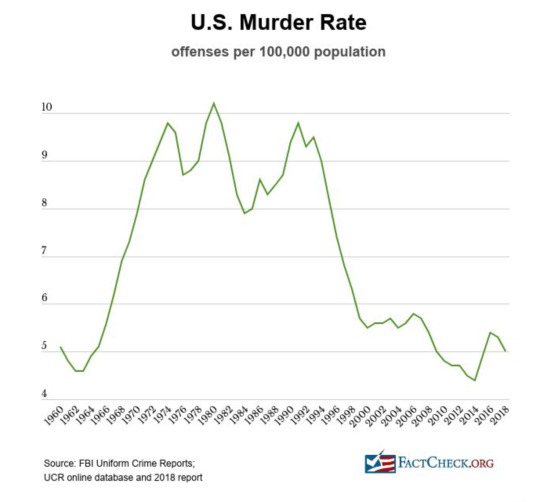
So basically, after a rough couple of decades, we’re back to where we were in 1960. But we’re actually much worse, because improvements in medical technology are keeping a lot of people that would’ve died 60 years ago alive. One paper from 2002 says that the murder rate would be 5 times higher if not for medical developments since 1960. I don’t know how much to trust this, but it’s surely true that we’ve made some medical progress since that time, and doctors have been getting a lot of experience from all the shooting victims they have treated over the decades. Moreover, we’re much richer than we were in 1960, and I’m sure spending on public safety has increased. With all that, we are now about tied with where we were almost three-quarters of a century ago, a massive failure.
What about psychology? As of 2016, there were 106,000 licensed psychologists in the US. I wish I could find data to compare to previous eras, but I don’t think anyone will argue against the idea that we have more mental health professionals and research psychologists than ever before. Are we getting mentally healthier? Here’s suicides in the US from 1981 to 2016
…
What about education? I’ll just defer to Freddie deBoer’s recent post on the topic, and Scott Alexander on how absurd the whole thing is.
Maybe there have been larger cultural and economic forces that it would be unfair to blame criminology, psychology, and education for. Despite no evidence we’re getting better at fighting crime, curing mental problems, or educating children, maybe other things have happened that have outweighed our gains in knowledge. Perhaps the experts are holding up the world on their shoulders, and if we hadn’t produced so many specialists over the years, thrown so much money at them, and gotten them to produce so many peer reviews papers, we’d see Middle Ages-levels of violence all across the country and no longer even be able to teach children to read. Like an Ayn Rand novel, if you just replaced the business tycoons with those whose work has withstood peer review.
Or you can just assume that expertise in these fields is fake. Even if there are some people doing good work, either they are outnumbered by those adding nothing or even subtracting from what we know, or our newly gained understanding is not being translated into better policies. Considering the extent to which government relies on experts, if the experts with power are doing things that are not defensible given the consensus in their fields, the larger community should make this known and shun those who are getting the policy questions so wrong. As in the case of the Afghanistan War, this has not happened, and those who fail in the policy world are still well regarded in their larger intellectual community.
…
Those opposed to cancel culture have taken up the mantle of “intellectual diversity” as a heuristic, but there’s nothing valuable about the concept itself. When I look at the people I’ve come to trust, they are diverse on some measures, but extremely homogenous on others. IQ and sensitivity to cost-benefit considerations seem to me to be unambiguous goods in figuring out what is true or what should be done in a policy area. You don’t add much to your understanding of the world by finding those with low IQs who can’t do cost-benefit analysis and adding them to the conversation.
One of the clearest examples of bias in academia and how intellectual diversity can make the conversation better is the work of Lee Jussim on stereotypes. Basically, a bunch of liberal academics went around saying “Conservatives believe in differences between groups, isn’t that terrible!” Lee Jussim, as someone who is relatively moderate, came along and said “Hey, let’s check to see whether they’re true!” This story is now used to make the case for intellectual diversity in the social sciences.
Yet it seems to me that isn’t the real lesson here. Imagine if, instead of Jussim coming forward and asking whether stereotypes are accurate, Osama bin Laden had decided to become a psychologist. He’d say “The problem with your research on stereotypes is that you do not praise Allah the all merciful at the beginning of all your papers.” If you added more feminist voices, they’d say something like “This research is problematic because it’s all done by men.” Neither of these perspectives contributes all that much. You’ve made the conversation more diverse, but dumber. The problem with psychology was a very specific one, in that liberals are particularly bad at recognizing obvious facts about race and sex. So yes, in that case the field could use more conservatives, not “more intellectual diversity,” which could just as easily make the field worse as make it better. And just because political psychology could use more conservative representation when discussing stereotypes doesn’t mean those on the right always add to the discussion rather than subtract from it. As many religious Republicans oppose the idea of evolution, we don’t need the “conservative” position to come and help add a new perspective to biology.
The upshot is intellectual diversity is a red herring, usually a thinly-veiled plea for more conservatives. Nobody is arguing for more Islamists, Nazis, or flat earthers in academia, and for good reason. People should just be honest about the ways in which liberals are wrong and leave it at that.
…
The failure in Afghanistan was mind-boggling. Perhaps never in the history of warfare had there been such a resource disparity between two sides, and the US-backed government couldn’t even last through the end of the American withdrawal. One can choose to understand this failure through a broad or narrow lens. Does it only tell us something about one particular war or is it a larger indictment of American foreign policy?
The main argument of this essay is we’re not thinking big enough. The American loss should be seen as a complete discrediting of the academic understanding of “expertise,” with its reliance on narrowly focused peer reviewed publications and subject matter knowledge as the way to understand the world. Although I don’t develop the argument here, I think I could make the case that expertise isn’t just fake, it actually makes you worse off because it gives you a higher level of certainty in your own wishful thinking. The Taliban probably did better by focusing their intellectual energies on interpreting the Holy Quran and taking a pragmatic approach to how they fought the war rather than proceeding with a prepackaged theory of how to engage in nation building, which for the West conveniently involved importing its own institutions.
A discussion of the practical implications of all this, or how we move from a world of specialization to one with better elites, is also for another day. For now, I’ll just emphasize that for those thinking of choosing an academic career to make universities or the peer review system function better, my advice is don’t. The conversation is much more interesting, meaningful, and oriented towards finding truth here on the outside.
11 notes
·
View notes
Link
via Politics – FiveThirtyEight
Americans opposed to President Trump are constantly asking some version of this question: “Why won’t Republicans break with Trump?”
The personalities on Fox News are largely standing with the president amid the controversy over the Trump administration pushing Ukrainian officials to investigate the business dealings of Joe Biden’s son. So are Republicans in Congress. Vice President Mike Pence and others inside the Trump administration are also defending the president’s actions involving Ukraine (a shift from when one-time Trump advisers like Dan Coats would sometimes signal disagreement with the president’s stances).
But looking at Trump’s standing only among people currently inside of powerful Republican-controlled spaces — the party itself, Fox News, the White House, etc. — presents an incomplete picture and understates opposition to Trump among Republican politicians and activists. Almost by definition, that opposition can’t happen within the obvious GOP spaces — the president and his acolytes have accumulated enough power that it’s increasingly hard to be both be anti-Trump and a Republican in good standing at a major conservative institution.
So Rep. Justin Amash of Michigan left the GOP and became an independent. Former Rep. Mark Sanford of South Carolina lost in a primary last year to an opponent endorsed by Trump after speaking out against the president. And just last Friday, Fox News anchor and occasional Trump critic Sheppard Smith resigned,1 as did Homeland Security Secretary Kevin McAleenan, who had occasionally clashed with the president.
Indeed, widen your lens and you can find all kinds of anti-Trump sentiment in conservative and right-leaning circles. This anti-Trump bloc, in addition to Republicans still supporting the president, might have lots of sway as impeachment unfolds — if they can reach GOP voters.
The media
You could create your very own conservative, anti-Trump TV network if you hired all the Trump-skeptical Republicans who regularly appear as talking heads on CNN and MSNBC. CNN, for example, has Amanda Carpenter, Charlie Dent, John Kasich, and Mia Love. MSNBC boasts Carlos Curbelo, Susan Del Percio, Elise Jordan, Mike Murphy, Jennifer Rubin, Joe Scarborough, Michael Steele, Charlie Sykes, Nicole Wallace, George Will and Rick Tyler.2
Yes, most conservative pundits on Fox News are heartily pro-Trump, but not all conservative pundits are on Fox News.
Elected officials
There were 241 Republicans in the U.S. House in early 2017, at the start of Trump’s tenure. Since then, more than a quarter have either been defeated at the ballot box, in last November’s elections (29), or retired (36).3 Some of them, such as former Rep. Mia Love of Utah, blame Trump’s unpopularity for their defeats. Others, such as Rep. Will Hurd of Texas, hint that they are leaving Congress in part because they are uncomfortable with the direction Trump is taking the GOP, as the Washington Post recently reported in a story detailing the exodus of House Republicans.
There is also a group of Trump-skeptical governors and senators — most notably former Sen. Jeff Flake of Arizona and former Gov. John Kasich of Ohio — who left their posts after 2018. And then you have figures like former Rep. Joe Walsh of Illinois , ex-Gov. William Weld of Massachusetts and Sanford, all of whom are running long-shot primary challenges to Trump. Former Rep. Bob Inglis of South Carolina, who has publicly come out against Trump, is suing his state’s Republican Party in an effort to overturn its decision to cancel next year’s Republican primary, a move designed in part to boost the president.
So, in addition to that conservative, anti-Trump cable channel, you could also piece together a Senate majority (51 people) from Republicans who have previously served in either the House or the Senate but who have been publicly wary of Trump.
Senior Republican staffers
OK, if you’re going to have a shadow, anti-Trump GOP Senate, you need some experienced Republican operatives to staff it. You won’t have to look too hard.
In a clear and public rebuke to Trump, chiefs of staff for Republican presidents Ronald Reagan, George H.W. Bush and George W. Bush recently told the New York Times that the presidents they served would never have asked for help winning an election from a foreign government. A group of conservative lawyers, many of whom served in top positions in the Department of Justice under Reagan or one of the Bushes, are supporting the impeachment inquiry.
Moreover, plenty of people who served in senior roles in the Trump administration itself, including H.R. McMaster (national security adviser), Anthony Scaramucci (communications director) and Rex Tillerson (secretary of state) have distanced themselves from the president.
Again, the Republican staffers currently in the White House are defending the president, but that might mask some broader disagreement among senior-level Republican staffers.
Conservative institutions
Many organizations on the right, such as the Heritage Foundation, are in lockstep with the president. But others — the Cato Institute, the Niskanen Center — are fairly critical of him
Or, take the white evangelical conservative movement as a whole. It is often portrayed as totally behind the president, and news stories often cite people like Jerry Falwell Jr. who are closely allied with the president to show that. But white evangelicals aren’t completely aligned with Trump — a generational gap has begun to open up. And really, people like Falwell, who runs a small Christian college (Liberty University), are more accurately described as evangelical leaders who support Trump, rather than evangelical leaders. overall. J.D. Greear, head of the Southern Baptist Convention, is more clearly a “leader” of America’s evangelicals — and he is kind of lukewarm about Trump.
So it’s important to understand that many conservative organizations and power centers on the right are strongly behind Trump, but also that increasingly “conservative” has come to mean “pro-Trump,” a narrative that writes out of the story organizations and people who had what were considered fairly rightly-leaning views pre-Trump.
OK, I admit this is an imprecise exercise. What overall percentage of elite Republicans — conservative media figures, current and former members of Congress, current and former administration officials, etc. — oppose Trump? That’s basically impossible to quantify.
But I think it’s higher than often portrayed — because some opposition lives in non-GOP spaces where people aren’t looking, and because much of it is also hidden from view, as elected Republicans face strong incentives to stand by Trump publicly.
All of this helps explain why Republican voters are among the most loyal-to-Trump constituencies in the Republican Party. Surveys have long suggested that between 85 and 90 percent of Republican voters approve of the president. Only about 13 percent of people who voted for Mitt Romney in 2012 said that they disapproved of Trump in a poll conducted in late 2018 and early 2019 by the Democracy Fund Voter Study Group. According to FiveThirtyEight’s average of impeachment polls, about 14 percent of Republicans support impeachment.
I wrote recently about how rank-and-file voters often follow cues from elites, noting that impeachment support increased among Democrats after the party unified around the idea. So maybe if we had full data on the views of all Republican elites, we’d find that about 10 to 15 percent oppose Trump, perfectly in line with voters.
But I think that the safer assumption is this: Trump has in many ways successfully purged his critics from the power centers of the GOP. So a potential resistance to him among Republican elites doesn’t just face the obvious challenge that he’s the president and popular among GOP voters. Republican elites who are wary of Trump are also not well situated to make their case to rank-and-file Republican voters. They are working in lobbying shops or boardrooms instead of on Capitol Hill, speaking to audiences on CNN and MSNBC instead of Fox News, and outside of the administration instead of inside it.
The facts of the Ukraine case, or its politics, could open more doors for those anti-Trump voices in those pro-Trump spaces. That would likely have profound effects on the views of GOP voters.
For now, though, the Trump-skeptical bloc in Congress remains a small part of the overall Trump-skeptical conservative coalition.
1 note
·
View note
Text
A blog post about How to Build an Online Survey with No-Code Platforms Building an online survey can be easy if you choose a platform that doesn't require coding. This often means the survey will take a while to set up, but it will be much easier to navigate. With no-code platforms, you can easily create a survey with a couple of clicks, and you can also view the results on a dashboard. To build a survey free with no-code platforms, this blog will look at the steps you should take.Table of ContentHow to build an online survey?Why online surveys are important?How to build your survey with a free online survey platformWhat are trending online survey platforms? How to build an online survey? Online surveys are a great way to assess customer satisfaction, market research, and market trends without having to go through the hassle of hiring a survey company. Why online surveys are important? Online surveys are one of the best ways to collect data with minimal effort and time. They are easy to use and are accessible on a variety of devices. They also provide a greater opportunity for respondents to be honest about their attitudes, thoughts, and feelings.Whether you need to collect data for a marketing campaign, service, or product, or if you’re simply looking for feedback from your customers or consumers, online surveys can help you get the information you need. How to build your survey with a free online survey platform. Building a survey is a lot easier than you think, and all you need is a free online survey platform. There are plenty of these platforms out there. The best part is that they are all no-code, meaning that you don't need any knowledge of coding to get started. With these platforms, you can build your survey in no time. There are many different features you can use to make your survey. What are trending survey platforms? 1 Substack Substack is an online platform based in the United States that allows subscription newsletters to be published, paid for, analyzed, and designed. It enables writers to deliver digital newsletters to subscribers directly. Added to wishlistRemoved from wishlist 0 Add to compare Demo Read full review 2 Survey Junkie Added to wishlistRemoved from wishlist 0 Add to compare Demo Read full review 3 Google Forms Added to wishlistRemoved from wishlist 0 Add to compare Demo Read full review 4 SurveySparrow SurveySparrow is a customer experience solution that helps organizations of all kinds create interactive feedback surveys in the cloud. Using a single dashboard, users may enter contacts and organize them into custom lists based on job titles, area, and age categories.
Added to wishlistRemoved from wishlist 2 Add to compare $19.00 Demo Read full review 5 Formstack Formstack is a cloud-based solution for organizations to develop and collect data for overviews, leads, and enlistments. Routing, file uploads, data encryption, discount coupons, and form analytics are all possible options. Added to wishlistRemoved from wishlist 0 Add to compare $50.00 Demo Read full review Analyst Choice 6 AppSheet AppSheet is a no-code application development platform that allows users to construct mobile, tablet, and online apps utilizing data from Google Drive, DropBox, Office 365, and other cloud-based spreadsheet and database systems. Project management, client relationship management, field inspections, and tailored reporting are just a few of the corporate use cases that the platform can handle. Added to wishlistRemoved from wishlist 1 Add to compare $5.00 Demo and Details Read full review 7 Enveu Businesses may use the Enveu suite of solutions to develop OTT applications on several platforms, track and better understand user behavior, monetize content, and perform digital marketing campaigns against the experience. Added to wishlistRemoved from wishlist 0 Add to compare Demo Read full review 8 SurveyLegend Added to wishlistRemoved from wishlist 0 Add to compare $15.00 Demo Read full review 9 survicat Added to wishlistRemoved from wishlist 0 Add to compare $89.00 Demo Read full review 10 Heyflow Heyfow
is indeed a customer management system that helps companies engage visitors, manage sales, and turn visitors into customers. Added to wishlistRemoved from wishlist 0 Add to compare $33.00 Demo Read full review 11 Caspio Caspio is a one-of-a-kind, cloud-based, and simple-to-use program that offers an all-in-one platform for customers to easily construct bespoke database applications. This tool includes all of the capabilities you'll need to quickly design, construct, and deploy your bespoke database applications. Added to wishlistRemoved from wishlist 1 Add to compare $119.00 Demo Read full review Show next Keep Updated On Latest News Subscribe now to receive interesting news, articles, blogs and event details Subscribe Now Interesting Articles5 Best Smart Low-Code Survey Builder5 Best Survey & Feedback Apps Development Low-Code PlatformsHow to Build an Online Survey with No-CodeBest 13 Online Free Survey Builders9 Top Paid Survey Platforms to Make Money
0 notes
Text
Textbooks to Slides: IP Attorney Brenda Ulrich on Legal Image Use in Anatomy & Physiology | TAPP 150
In Episode 150 of The A&P Professor podcast, host Kevin Patton speaks with intellectual property attorney Brenda Ulrich about copyright law and image use in education. They discuss how educators often mistakenly assume they have rights to use textbook images and the complexities of permissions that expire. Brenda highlights the differences in legal standards for physical versus online teaching and emphasizes the importance of understanding licensing agreements and fair use. By the end, listeners gain valuable insights into legally and ethically incorporating multimedia into their anatomy & physiology courses.
0:00:21 | Host: Kevin Patton 0:00:47 | Introducing Brenda 0:03:49 | You Need a License 0:26:12 | Staying Up To Date 0:27:15 | Put Yourself in Their Shoes 0:41:55 | Do You Write? 0:43:54 | I need a handout 1:00:19 | Finding Media 1:02:00 | Can I Put My PowerPoint on YouTube? 1:12:43 | Staying Connected
★ If you cannot see or activate the audio player, go to: theAPprofessor.org/podcast-episode-150.html
🏅 Apply for your credential (badge/certificate) for listening to this episode: theAPprofessor.org/podcast-episode-150.html/#badge
⭐⭐⭐⭐ Please rate & review this podcast so that others can decide whether to give it a try: RateThisPodcast.com/theAPprofessor
❓ Please take the anonymous survey: theAPprofessor.org/survey
☝️ Questions & Feedback: 1-833-LION-DEN (1-833-546-6336)
✔️ Follow The A&P Professor on Twitter, Facebook, Blogger, Substack, Tumblr, or Instagram! @theAPprofessor
📰 Get the once-or-twice-weekly TAPP Science & Education Updates theAPprofessor.org/updates
If you have integrity, nothing else matters. If you don't have integrity, nothing else matters. (Alan K. Simpson)
Introducing Brenda
3 minutes
Host Kevin Patton introduces guest Brenda Ulrich.
You Need a License
22.5 minutes
In this discussion, Kevin and Brenda address common questions about using textbook images in teaching, focusing on the legalities and fair use of copyrighted materials. Brenda explains that when using images from textbooks, the license agreement with the publisher governs permissible usage. She emphasizes the importance of reviewing license agreements carefully, even for optional or non-adopted materials. Additionally, Brenda highlights the distinction between classroom use and broader sharing, such as online, and advises seeking permissions or using resources like libraries to ensure proper licensing.
Staying Up To Date
1 minute
Taking a brief break, Kevin reminds listeners about his occasionally regular Substack newsletter, The A&P Professor Science & Education Updates.
Put Yourself in Their Shoes
14.5 minutes
In this conversation, Kevin raises a scenario about reusing images from a previously adopted textbook in his new course materials. Brenda explains that continuing to use such content after switching textbooks would exceed the original license's scope, making it unethical and illegal. She advises always seeking permission from the publisher, not the author, for such uses. Brenda also highlights potential legal consequences of copyright infringement, including fines and lawsuits, stressing the importance of being ethical and avoiding copyright violations.
Do You Write?
2 minutes
Briefly stepping away from the conversation, Kevin reminds listeners about the advantages of membership in the Textbook & Academic Authors Association (TAA). Any kind of academic writer, whether textbooks, manuals, lab exercises, dissertations, journal or other articles, reports, or grants, benefit from the resources and networking TAA offers. Listen for a special deal for new members!
I Need a Handout (and a Sandwich)
16.5 minutes
In this conversation, Kevin asks Brenda if creating a handout for students automatically gives him copyright protection. Brenda confirms that any work in a tangible form is copyrighted, whether registered or not. She advises adding a copyright notice and registering valuable works to protect against unauthorized use. They discuss the risks of copyright infringement, including potential legal consequences, and highlight the benefits of using licenses like Creative Commons for sharing work. Brenda also clarifies that reproducing lab exercises without permission is illegal, even if it's common practice in underfunded schools.
Finding Media
1.5 minutes
Yep, another short break. This time, Kevin reminds listeners that The A&P Professor website lists places to find free and legal media to use in teaching anatomy & physiology.
Can I Put My PowerPoint on YouTube?
10.5 minutes
In this segment, Kevin asks if it's permissible to upload PowerPoint presentations with textbook images onto public platforms like YouTube or SlideShare. Brenda explains that such usage would likely exceed the scope of permissions granted for classroom use, and extra permission would be required. She also clarifies that even if the material is uploaded to a closed platform, such as an LMS like Canvas or Blackboard, permission is still typically needed as it extends beyond classroom teaching. They discuss fair use, emphasizing that transformative use, such as critical analysis, may qualify as fair use, but general teaching does not.
Links
Archstone Law Group PC (Brenda's biography posted at her law firm's website) archstonelaw.com/attorneys/brenda-ulrich/
Copyright Clearance Center (mentioned in this episode, this organization will provide permissions to copy protected works) AandP.info/ws3
Creative Commons licenses (provides a variety of licenses that allow various levels of permissions for copyrighted work) AandP.info/bf7
Anatomia Italiana (discover connections between art and anatomy with Kevin Petti) anatomiaitaliana.com/
Visual Anatomy & Physiology (example of a Kevin Petti textbook) geni.us/gHmsF
U.S. Copyright Office (here's where you can register a copyright in the United States) copyright.gov/
Canadian Copyright (where you can register a Canadian copyright) AandP.info/6gy
Australian Copyright Council (where you can register an Australian copyright) copyright.org.au
Textbook & Academic Authors Association (get a great deal on TAA membership) taaonline.net
Haymakers for Hope (help knockout cancer by supporting Brenda's boxing adventure) AandP.info/cpt
Finding Media | Images and More for Teaching Anatomy & Physiology
Suggest a Media Source for Teaching A&P
Using Media in Our A&P Course | Advice From Barbara Waxer | Episode 28
The A&P Professor Science & Education Updates theAPprofessor.org/updates
People
Production: Aileen Park (announcer), Andrés Rodriguez (theme composer, recording artist), Karen Turner (Executive Editor), Kevin Patton (writer, editor, producer, host).
Not People
Robotic (AI) audio leveling/processing by Auphonic.com, initial draft transcript by Rev.com, and the content, spelling, grammar, style, etc., of these episode notes are assisted by various bots, such as ChatGPT, Grammarly, and QuillBot.
If the hyperlinks here are not active, go to TAPPradio.org to find the episode page.
★ More details at the episode page: theAPprofessor.org/podcast-episode-150.html
★ Transcript available in the transcript box: theAPprofessor.org/podcast-episode-150.html
★ Need help accessing resources locked behind a paywall? Check out this advice from Episode 32 to get what you need! my-ap.us/paywall
Take The A&P Professor experience to the next level!
★ theAPprofessor.org/community
Earn cash by referring other A&P faculty to this podcast:
★ theAPprofessor.org/refer
Tools & Resources
★ TAPP Science & Education Updates: theAPprofessor.org/updates
Follow The A&P Professor on Twitter, Facebook, Mastodon, Reddit, TikTok,LinkedIn, Blogger, Substack, Tumblr, or Instagram @theAPprofessor
The A&P Professor® and Lion Den® are registered trademarks of Lion Den Inc. (Kevin Patton)
Check out notes and transcript for this episode!
0 notes